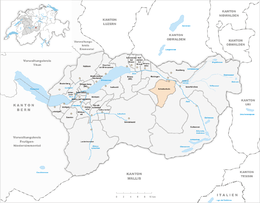Schattenhalb
| Schattenhalb | ||
|---|---|---|

Waterfall in Rosenlaui canyon near Schattenhalb
|
||
|
||
| Coordinates: 46°43′N 8°11′E / 46.717°N 8.183°ECoordinates: 46°43′N 8°11′E / 46.717°N 8.183°E | ||
| Country | Switzerland | |
| Canton | Bern | |
| District | Interlaken-Oberhasli | |
| Government | ||
| • Mayor | Niklaus Leuenberger | |
| Area | ||
| • Total | 31.53 km2 (12.17 sq mi) | |
| Elevation (Willigen im Tal village) | 600 m (2,000 ft) | |
| Population (Dec 2015) | ||
| • Total | 578 | |
| • Density | 18/km2 (47/sq mi) | |
| Postal code | 3860 | |
| SFOS number | 0786 | |
| Surrounded by | Meiringen, Innertkirchen and Grindelwald | |
| Website |
www SFSO statistics |
|
Schattenhalb is a municipality in the Interlaken-Oberhasli administrative district in the canton of Bern in Switzerland. The municipality includes the settlements of Willigen, Geissholz, Falcheren and Lüögen.
The municipality was created in 1834 from the cooperative farms (Bäuerten) of "Willigen," "Geissholz," "Falchern" and "Lugen." The name Schattenhalb ("Shadow-half") refers to the shady face of the mountainside south of Meiringen.
The oldest traces of settlements in the area are scattered Bronze Age ax and spear heads and a Roman era coin hoard. By the Middle Ages the scattered Bäuerten of Schattenhalb were part of the parish of Meiringen and the Vogtei of Hasli. In 1334 the entire Vogtei was acquired by the city of Bern.
Traditionally the villagers raised cattle and horses in seasonal alpine meadows and then sold the livestock and cheese to traders. During the 18th and 19th century authors, such as Charles Victor de Bonstetten and Jakob Samuel Wyttenbach, explored and described the natural beauty of the canyons, waterfalls and glaciers of the Bernese Oberland including many sights near Schattenhalb. Tourists began to visit the area and explore the land around the municipality. In 1788 the Rosenlauibad (Rosenlaui baths or pools) opened and by the 19th century a hotel and spa developed at the Rosenlaui river. A spa opened along the Reichenbach river before 1800 followed by a hotel in 1835. A cable car was built in 1899 which allowed guests to travel to the top of the falls. Reichenbach hotel burned in 1901 and was rebuilt as a larger, luxury hotel. However, it was converted into a psychiatric hospital in 1919. The nearby Aare gorge became a tourist destination in 1888. Between 1912 and 1956 a tram connected Meiringen, Schattnehalb and the Aare gorge. Today the municipality shares a post office and telephone exchange with Meiringen. While some residents still are involved in agriculture, about three-fourths of the jobs in Schattenhalb are in the services sector.
...
Wikipedia




